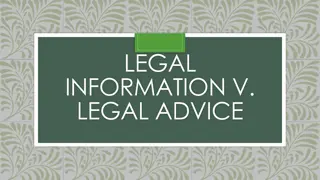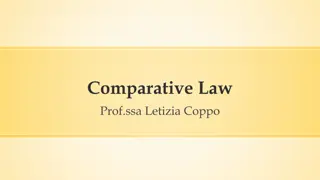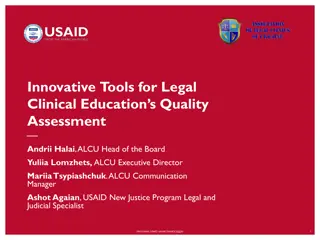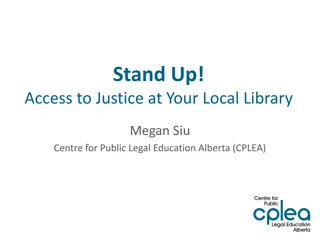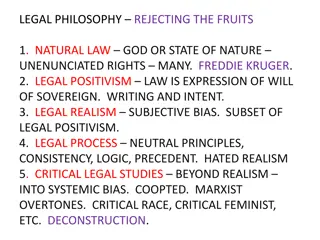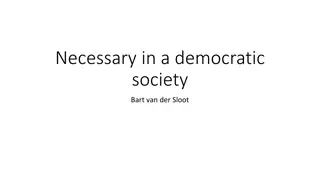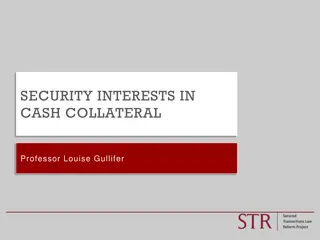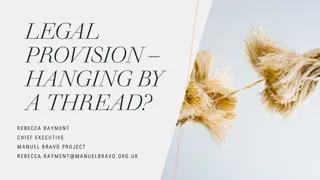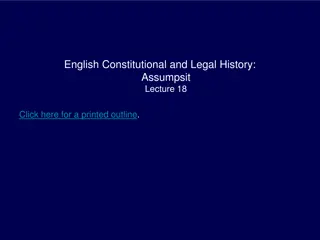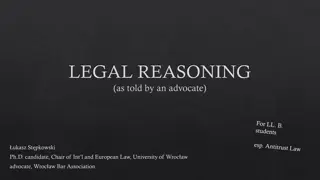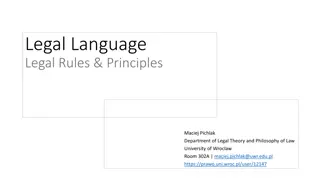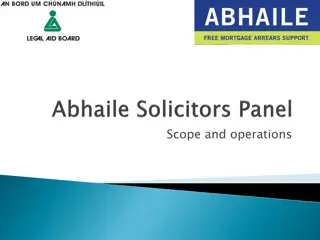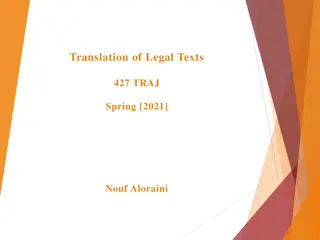Future Interests in English Legal History
Future interests in English legal history encompass remainders, executory interests, and settlements during the 16th and 17th centuries. These concepts involve different types of future interests in parties beyond the grantor, such as vested and contingent remainders, as well as springing and shifting executory interests. Developments in the doctrine of perpetuities and destructibility played crucial roles in shaping these legal principles.
Download Presentation

Please find below an Image/Link to download the presentation.
The content on the website is provided AS IS for your information and personal use only. It may not be sold, licensed, or shared on other websites without obtaining consent from the author.If you encounter any issues during the download, it is possible that the publisher has removed the file from their server.
You are allowed to download the files provided on this website for personal or commercial use, subject to the condition that they are used lawfully. All files are the property of their respective owners.
The content on the website is provided AS IS for your information and personal use only. It may not be sold, licensed, or shared on other websites without obtaining consent from the author.
E N D
Presentation Transcript
English Constitutional and Legal History: Future Interests, 1500 1700 Lecture 25 Click here for a printed outline.
Future interests in parties other than the grantor remainders Pur avoider le stuffing del rolls ove multip Remainder a future interest in a party other than the grantor that follows upon the natural expiration of a supporting freehold estate. There must at all times be someone who is seised of the freehold. Prior to the 16th century the most common examples of remainders were a remainder in fee tail following a present estate in fee tail and a remainder in fee simple or fee tail following dower or curtesy. In the 16th c. it becomes clear that remainders are of two kinds: Vested no conditions precedent other than the natural expiration of the supporting estate Contingent all others
Future interests in parties other than the grantor executory interests Executory interests a future interest that does not follow upon the natural expiration of a supporting freehold estate. They come in two kinds: Springing cutting off the grantor s fee in mid-course, including interests following, e.g. a term of years. O >A if he marries my daughter O >A for 50 years >remainder B and his heirs Shifting following a contingency that cuts a vested estate in a third party off short of the natural expiration period. O >A for life >remainder B and his heirs, but if B dies before A >remainder C and his heirs
Executory interests (contd). Examples of executory interests prior to the 16th century do not exist (the reversion, possibility of reverter or right of entry future interests retained by the grantor are always treated as sui generis). What happens in the 16th century is that conveyancers begin to use the statute of uses to create legal executory interests. Then they use the exceptions to the statute to create equitable ones. What they are playing with are two nascent doctrines, one new in the 16th century, the doctrine of perpetuities, the other probably more ancient, the doctrine of destructibility, the confines of which had not been explored.
Settlements (Baker pp. 31846, in a somewhat different order)
The fee tail and the beginning of the doctrine about perpetuities The durability of the fee tail from De donis (1285) to the mid-15th century; herewith of Bereford, CJCP, in 1312. Taltarum s Case (1472) and the common recovery as a means of docking entails. Conditional defeasances to A and the heirs of his body until A attempts to alienate, remainder to B and the heirs of his body, etc. The old rule against perpetuities, temp. Eliz. I. Maitland s mistake. .
Remainders The Provost of Beverley s Case (1366) To my eldest son in fee tail male, remainder to my right heirs. The eldest son died without issue, and his brother entered, and was said to in by inheritance rather than purchase, so that the lord was entitled to a relief. Full recognition of contingent remainders (Colthirst v. Bejushin 1550) To A and B for their joint lives, remainder to the survivor, remainder to C for life if he resides on the property, remainder to D for life if he resides on the property, with a reversion in the grantor the heir of a living person is the only one discussed in the Middle Ages.
Remainders (contd) No indefinite remainders To A for life, remainder to his male heir for life, remainder to his male heir for life, etc. holding in Perrrot s Case (1580) is that the remainders must vest before the determination of the first particular estate. Destructibility not fully established until Chudleigh s Case [Dillon v. Freine] in 1595 To A for life, remainder to his first born son in fee tail male, with remainders over. Even here the statement is dictum, but strong dictum saying that had the interest in question been a remainder and the contingency not been fulfilled when A conveyed, the remainder would have been destroyed. Both medieval and early modern courts clearly have problems with the concept of contingent remainders.
Executory interests Entailed uses are the only ones discussed prior to the Statute of Uses, and this so far as we can tell only academically. Scintilla juris (Dyer s phrase) validating the interests in a grant to A to use of B for life remainder to C (the problem was that the seisin was in B by the stat; nothing in the statute spoke of B s seisin supporting a remainder) same applied to wills by brute force. Shelley s Case (1581) To the use of X for life remainder after 24 years to the heirs male of the body of X in tail male converted to a fee tail in X (the issue was a child en ventre [great-grandson, the heir by descent] vs. X s 2d son [the taker by remainder]). Chudleigh s Case (1595) establishes the destructibility of both contingent remainders and executory interests.
Shifting and springing uses (following a term) will be treated below under the Duke of Norfolk s Case.
Pells v. Brown (1620) Devise To A and his heirs but if A dies without heirs of his body in the lifetime of B, to B and his heirs ; then A suffers a common recovery. Held: that the executory interest in B was not destroyed by the common recovery.
Purefoy v. Rogers (1671) The facts are enormously complicated but the holding is that if it can take effect as a remainder, it will be treated such.
From the 16th c. to the 17th c. In the 16th c. the executory interest was developed following the rules about remainders. In the beginning of the 17th c. the conveyancers began to use new forms of executory interests, and Pells holds that these are not destructible. Now we need one more step:
The development of the use after the statute and settlements in equity. Leases, B not seised, copyhold too, out of this comes the lease and release, an invention, perhaps of Serjeant More, which becomes the preferred method of conveyance early in the 17th century, and livery of seisin and the Statute of Enrollments is dead. Active or special uses (collect the profits) exempted from the Statute of Uses. Uses for a purpose (charitable uses) exempted from the Statute of Uses. Trusts for a purpose even if not charitable, e.g., to defeat dower and/or create a married woman s separate equitable estate. .
The development of the use after the statute and settlements in equity.(cont d) Use on a use Tyrrell s Case (1557) express on implied (i.e., she bargained the land to the first usee (her son) the first is executed the second is void as repugnant, but enforced in Chancery in the Duchess of Suffolk s Case (1560) (secret use during the Marian persecutions), decided by Nicholas Bacon, Lord Keeper. Trustees to preserve contingent remainders are found as early as 1600 (not an invention of Orlando Bridgeman), but not firmly held valid in equity until Mansell v. Mansell (1732), which may be one reason why Bridgeman did not use it in the settlement that gave rise to the Duke of Norfolk s Case.
The Duke of Norfolks Case cast of characters iHenry Frederick Howard, 15th earl of Arundel, 5th earl of Surrey, and 2nd earl of Norfolk (1608 1652), the settlor. Sir Orlando Bridgeman (1609 1674), who drafted the settlement. After the Restoration, he served as CBEx, CJCP, and, ultimately, Lord Keeper of the Great Seal. Thomas Howard (1627 1677), 16th earl of Arundel, eldest son of Henry Frederick, who died without issue. Charles Howard (1630 1713), fourth son of Henry Frederick, the plaintiff Henry Howard (1628 1684), 6th duke of Norfolk, second son of Henry Frederick, the defendant. Heneage Finch, 1st earl of Nottingham (1621 1682), lord Chancellor, who decided the case.
The Duke of Norfolks Case the settlement To trustees to the use of the Grantor for life, remainder to the grantor s wife for life, remainder to trustees for a term of 200 years, remainder to Henry and the heirs male of his body, with remainders over. Legal freehold interests in the land at the time of the grant: G present life estate. G s wife, remainder for life. Henry, remainder in fee tail male, etc. Legal non-freehold interests in the grant: a term of years in trustees to commence upon the death of the grantor s wife. During the term of years, the trustees were to hold to the use of Henry in fee tail male, but if Thomas die without issue in the lifetime of Henry or if Thomas s issue fail so that Henry inherits the earldom, to the use of Charles in fee tail male , with remainders over.
The Duke of Norfolks Case the settlement (contd) Equitable interests: Equitable fee tail male in Henry, determinable after 200 years or upon the death of Thomas or his male issue, subject to a shifting executory interest in Charles if Thomas should die without issue during Henry s lifetime or if Thomas issue failed so that Henry inherited the earldom. (Charles executory interest in the term was also in fee tail with remainders over, but the court holds the reminder interests to be void in both law and equity, thus giving Charles an executory interest in the entire term.) Why weren t the equitable interests executed into legal ones by the statute? The trust was not an active one. The statute only executed uses of freeholds. This was a use on a use. A classic example of belt-and-suspenders conveyancing.
The Duke of Norfolks Case Henrys shenanigans After the death of his mother, Henry, now the holder of a present estate in fee tail male, suffered a common recovery to dock the entail. Then he obtained a conveyance from the remaining trustee of the term of years giving him a fee simple absolute at law by merger. In equity, because he took with notice of the term, he will hold subject to Charles interest if that interest is good and not void as a perpetuity.
The Duke of Norfolks Case Bridgemans machinations Serves some of the same purposes as trustees to preserve contingent remainders (i.e. if Henry forfeits, the interest in Charles is preserved or if Henry suffers a common recovery, as he did, the interest of Charles is preserved). Neither the validity of the trust to preserve nor of equitable future interests in a term of years was established when Bridgeman wrote. But if he sets it up this way he is assured that Charles interest is not a remainder (it s a fee on a fee, and remainders in terms of years are not allowed at law). Bridgeman was forum shopping he himself sustained while Lord Keeper a limitation very much like this one (Wood v. Sanders (1669)), although King s Bench affirmed by the Exchequer Chamber in Child v. Baylie (1623) had struck down one very much like this one. Besides Bridgeman knew Henry.
The Duke of Norfolks Case Nottinghams motivations A Perpetuity is the Settlement of an Estate or an Interest in Tail, with such Remainders expectant upon it, as are in no Sort in the Power of the Tenant in Tail in Possession, to dock by any Recovery or Assignment, but such Remainders must continue as perpetual Clogs upon the Estate; such do fight against God, for they pretend to such a Stability in human Affairs, as the Nature of them admits not of, and they are against the Reason and the Policy of the Law, and therefore not to be endured. Such do fight against God, i.e. the grantor-testator cannot envisage all the circumstances which will occur, it is undesirable to have interests outstanding for a long time. Note that this policy is particularly dependent on the inalienability of executory interests and contingent remainders. Why allow the interest to be created up to lives in being? A man should be able to provide for the contingencies of his own family that are within his view and prospect. Further a contrary holding would upset many marriage settlements.
Nottinghams motivations (contd) But where is the line? And where are the Bounds of that Contingency? You may limit, it seems, upon a Contingency to happen in a Life: What if it be limited, if such a one die without issue within twenty-one Years, or 100 Years or while Westminster-Hall stands? Where will you stop, if you do not stop here? I will tell you where I will stop: I will stop where-ever any visible Inconvenience doth appear . . . . Note the test visible inconvenience. The Rule Against Perpetuities ( No interest is good unless it must vest, if at all, within a life or lives in being at the creation of the interest plus 21 years. ) as opposed to the doctrine of perpetuities is a 19th-century creation. Does one view the case as for or against perpetuities? The social point in its context is not quite what you might think. Once we see clearly that the decision is pro-perpetuities and not anti, it s all too easy to fall into the Habbakuk thesis about the rise of the great estates.
The strict settlement We should, however, be cautious in doing so. For the most part, the great families did not use the type of device that Bridgeman created, they used the strict settlement: To G for life, remainder to G s wife for life, remainder to trustees for 10 yrs to raise portions, remainder to Thomas for life, remainder to trustees for the life of G and Thomas to preserve contingent remainders, remainder to Thomas s eldest son in fee tail. Obviously, this would not work in the situation of the earl of Arundel because it was anticipated, and it in fact panned out, that Thomas would not have issue. But most eldest sons are not sickly or mentally incompetent. How does this work in the more normal case? Thomas has a life estate. He may also have the reversion. Even if he does not, he may be able to get it. Were it not for the trustees to preserve contingent remainders, Thomas with the life estate and the reversion could destroy the contingent remainder in the eldest son, so long as he does not have one. Once he does, however, the eldest son has a vested remainder which can t be destroyed.
The strict settlement (contd) But the eldest son is a baby, and he can t make any conveyances so long as he is under 21. When he reaches the age of 21, he approaches his father and asks for money so that he can go up to London and make a splash in the social season. Dad says sure, but first we have to go see the family solicitor and do some business. Thomas conveys his interests to the solicitor. Thomas Jr. conveys his interest to the solicitor. The solicitor ends up with a fee simple absolute. The solicitor then conveys back to To Thomas for life, remainder to Thomas s wife for life, remainder to trustees for 10 yrs to raise portions, remainder to Thomas, Jr. for life, remainder to trustees for the life of Thomas and Thomas, Jr. to preserve contingent remainders, remainder to Thomas Jr. s eldest son in fee tail male. Hence, the strict settlement works, so long as it is renewed in each generation. Many of them were. The strict settlement did not become unpopular until after World War II, when it was subject to increasingly confiscatory taxation.
The strict settlement (contd) The beauty of the system, at least theoretically, is that it preserves the estate in perpetuity so long as in each generation father and son can agree to a new settlement in a situation in which the son does not have many bargaining chips. And the present holder never has anything more than a life estate, so that he can t commit waste or dissipate the estate. When it comes time to resettle, he has a 21-year old son, and thus is in respectable middle age and likely to have the interests of the dynasty very much in mind. The way that it works depends on the psychology of relations between parents and children that seem to be virtually universal. This works so long as the life tenant and his eldest son are alive when the son has reached the age of 21. That was much less common in the 18th century than it is today. How often the resettlement was made between father and son, and what happened when the father did not survive until the son reached the age of 21 requires further work. It may turn out that many fatherless 21-year old heirs were persuaded by cultural forces and/or their mothers to suffer a common recovery and resettle the estate in strict settlement form, even though they were not being leaned on by their fathers to do so.
The strict settlement (contd) One factor that may have persuaded them to do this is that English bankers were willing to lend money to the present holders of great estates, even though they could not mortgage them, because they knew that eventually they would get paid with interest by the trustees who were to raise portions after the present holder died. But that s just a guess. There may have been something in the literature that I ve missed. I m no specialist in the 18th century, but my impression is that the work simply hasn t been done.
The Duke of Norfolks Case the conclusion Lord Nottingham died in 1682 shortly after rendering his decree. Francis North, CJCP, who had opined against the validity of the settlement became Lord Keeper. Henry petitioned for a rehearing and Nottingham s decision was reversed. Then Henry died, and then Charles II died. Charles Howard brought a petition in the House of Lords to reverse North s decision and restore Nottingham s decree. On 19 June 1685, the House of Lords reversed Lord North s decree and reinstated Lord Nottingham s. Not the least of the ironies of the Duke of Norfolk s Case is that the present duke of Norfolk is a descendant of Charles and not of Henry. Henry s line died out in the 18th century.




